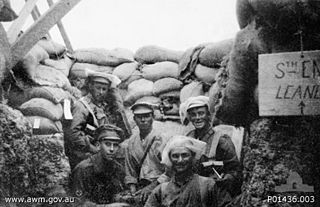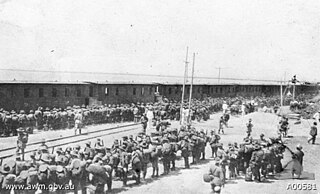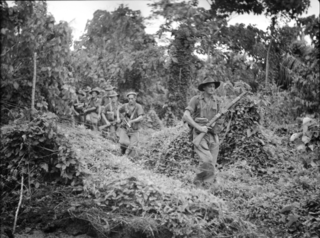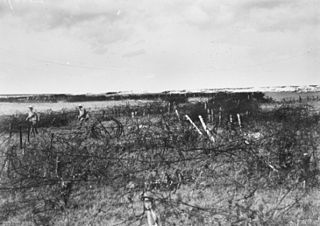
The Royal Queensland Regiment (RQR) is a reserve light infantry regiment of the Australian Army based in Queensland. Part of the Royal Australian Infantry Corps, the regiment was established in 1960 following a reorganisation of Australia's part-time infantry regiments that saw the creation of six state-based regiments through the amalgamation of the previously existing regionally designated infantry battalions. Initially only two battalions were raised, but since then the size of the regiment has fluctuated depending upon the Army's requirements. There are currently three battalions within the regiment based at various locations throughout Queensland, all of which are assigned to the 11th Brigade.

The 9th Battalion, Royal Queensland Regiment is a Reserve light infantry battalion of the Australian Army, raised and based in the state of Queensland. It is part of the Royal Queensland Regiment and is currently attached to the 11th Brigade of the 2nd Division. 9 RQR can trace its history as far back as 1867 with the establishment Queensland Volunteer Rifle Corps, although it was not until 1911 that it was designated as the "9th Battalion". Over the course of its history, the battalion has served Australia in a number of conflicts including The Boer War, World War I and World War II, while more recently, members of the battalion have been involved in various peacekeeping operations and exercises around the Pacific region.

The Royal New South Wales Regiment (RNSWR) is a reserve infantry regiment of the Australian Army based in the state of New South Wales.

The 1st Battalion was an infantry battalion of the Australian Army. Although its numerical name was designated during the First World War, the 1st Battalion can trace its lineage back to 1854, when a unit of the Volunteer Rifles was raised in Sydney, New South Wales. This unit has since been redesignated a number of times, but through its links with the units of the colonial NSW defence force, the battalion's history includes services in Sudan and South Africa. During the First World War, the 1st Battalion was raised for overseas service in 1914 as part of the First Australian Imperial Force. Attached to the 1st Brigade, the battalion served in Egypt initially before taking part in the fighting in Gallipoli against the Turks. Later the battalion was sent to the Western Front where it fought in the trenches in France and Belgium as part of the Australian Corps. Following the end of the war the battalion was disbanded in 1919.

The 3rd Battalion was an infantry battalion of the Australian Army. Originally raised as part of the First Australian Imperial Force for service during World War I, the battalion formed part of the 1st Brigade, attached to the 1st Division. It was formed shortly after the war broke out and was among the first Australian units to be sent overseas, arriving in Egypt in December 1914. In April 1915 the battalion participated in the Landing at Anzac Cove, coming ashore in the second and third waves. In December 1915 the 3rd Battalion was evacuated from the Gallipoli peninsula and withdrawn to Egypt again, where it took part in the defence of the Suez Canal before being sent to France to fight on the Western Front in March 1916. For the next two and a half years the unit would serve in the trenches in France and Belgium and would take part in many of the major battles fought during that time. In May 1919, following the end of the war, the battalion was disbanded and its personnel repatriated back to Australia.

The 4th Battalion was an infantry battalion of the Australian Army. Originally raised as part of the First Australian Imperial Force during the First World War, the battalion formed part of the 1st Brigade, attached to the 1st Division. During the war the battalion fought at Gallipoli and in the trenches on the Western Front, before being disbanded in 1919. In 1921, the battalion was re-raised as a militia unit and designated as the "4th Battalion ", adopting the designation of the Australian Rifles militia unit from which many of the battalion's recruits had come during the war. In 1930, the battalion was amalgamated with the 3rd Battalion and they remained linked until 1936, when they were delinked.
The 5th Battalion was an infantry battalion of the Australian Army. Raised in Victoria as part of the First Australian Imperial Force for service during World War I, the battalion formed part of the 2nd Brigade, attached to the 1st Division. It participated in the landing at Anzac Cove on 25 April 1915, coming ashore in the second wave, before taking part in the fighting at Krithia and then at Lone Pine. In December 1915, the battalion was withdrawn from the peninsula and returned to Egypt where it was involved in defending the Suez Canal until being transferred to the Western Front in France in early 1916. After that, over the course of the next two and a half years the 5th Battalion was rotated in and out of the front line and took part in a number of significant battles including at Pozieres, Ypres, Amiens and the Hindenburg Line. Following the end of the war, the battalion was disbanded and its personnel returned to Australia. The battalion was re-raised during the inter-war years as a part-time unit and was later mobilised during World War II, but did not serve overseas. During the post war period, the battalion has existed at various times before being subsumed into the 5th/6th Battalion, Royal Victoria Regiment.

The 6th Battalion was an infantry battalion of the Australian Army. Originally formed in 1914 for service during the First World War, the battalion fought at Gallipoli and on the Western Front. The battalion was disbanded in 1919 but was re-raised in 1921 as part of the Citizens Force, and adopted the title of "Royal Melbourne Regiment" in 1935. The battalion did not serve overseas during the Second World War and was eventually disbanded in 1944. It was re-raised in 1948 and remained in existence until 1960 when it was absorbed into the Royal Victoria Regiment. Today its honours and traditions are maintained by the 5th/6th Battalion, Royal Victoria Regiment.

The 7th Battalion was an infantry battalion of the Australian Army. Raised in 1914 as part of the Australian Imperial Force during the First World War, the battalion was completely recruited from the state of Victoria and formed the 2nd Brigade, 1st Division. The battalion served during the Gallipoli campaign where it had the distinction of having four of its members awarded the Victoria Cross. In 1916, it was transferred to Europe, fighting in the trenches along the Western Front for the next two and a half years.

The 8th Battalion was an infantry battalion of the Australian Army. Initially raised in 1914 for the First Australian Imperial Force during the First World War the battalion was completely recruited from Victoria and formed part of the 2nd Brigade, 1st Division. During the war it fought at Gallipoli and in France and Belgium on the Western Front. It was disbanded in 1919, before being re-raised as a Militia battalion in 1921. During the Second World War the 8th Battalion was used primarily as a garrison unit before taking part in the Bougainville campaign late in the war. It was disbanded again in 1946 during the demobilisation process, although it was reformed again in 1948 when it was amalgamated with the 7th Battalion. Today, its honours and traditions are perpetuated by the 8th/7th Battalion, Royal Victoria Regiment.

The 12th Battalion was an infantry battalion originally raised for the First Australian Imperial Force during the First World War. The battalion was recruited from Tasmania, South Australia and Western Australia and formed part of the 3rd Brigade, 1st Division. It served throughout the war, firstly during the Gallipoli Campaign and then on the Western Front. During the interwar years, the 12th Battalion was re-raised as a part-time military unit and during the Second World War undertook garrison duties in Australia, but did not see combat. Today its lineage is perpetuated by the 12th/40th Battalion, Royal Tasmania Regiment, a unit which continues to serve in the Australian Army Reserve.

The 17th Battalion was an infantry battalion of the Australian Army. Although its numerical designation was bestowed upon it during World War I, the 17th Battalion can trace its lineage back to 1860, when a unit of the New South Wales Volunteer Rifles was raised in St Leonards, New South Wales. This unit has since been disbanded and reformed a number times. Through its links with the units of the colonial New South Wales defence force, the battalion's history includes service in the Sudan and South Africa. During World War I, the 17th Battalion was raised for overseas service as part of the Australian Imperial Force. Attached to the 5th Brigade, 2nd Division, the battalion was raised in 1915 and sent to Egypt initially, before taking part in the fighting at Gallipoli against the Turks. Later the battalion was sent to the Western Front in France and Belgium, where it served in the trenches as part of the Australian Corps. Throughout the course of the war, the battalion won numerous battle honours and its members received many individual awards, however, at the end of the war the battalion was disbanded in April 1919.

The 19th Battalion was an infantry battalion of the Australian Army. Although the unit's numerical designation was bestowed upon it during World War I, the unit can trace its origins back to 1860 when a Volunteer Rifle corps was raised in South Sydney. During World War I, the 19th Battalion was raised as a unit of the Australian Imperial Force, attached to the 5th Brigade, of the 2nd Division. The unit was formed in 1915 and was first sent to Gallipoli where it fought against the Turks, before being withdrawn from the peninsula and being sent to France in early 1916, where it served in the trenches along the Western Front. Over the next two years the battalion fought in many major battles and won numerous battle honours. In April 1918, it took part in defending against the German Spring Offensive, before the Allies launched their own last-ditch effort as part of the Hundred Days Offensive. The battalion was disbanded in October 1918 due to manpower shortages in the AIF and most of its men were sent to reinforce the other three battalions of the 5th Brigade.

The 16th Battalion, Royal Western Australia Regiment is an Australian Army reserve infantry battalion located in Western Australia and one of the two battalions of the Royal Western Australia Regiment. The battalion was first formed during the First World War, during which it fought during the Gallipoli Campaign and on the Western Front in France and Belgium as part of the Australian Imperial Force. It was re-formed as a part-time unit in Western Australia during the inter-war years, and served in the New Britain Campaign against the Japanese during the Second World War. In the post war years, the battalion became part of the Royal Western Australia Regiment and currently forms part of the 13th Brigade.

The 2nd/17th Battalion, Royal New South Wales Regiment is a reserve infantry battalion of the Australian Army. Currently part of the 5th Brigade, attached to the 2nd Division, the unit currently consists of a headquarters, signals platoon and three rifle companies spread out across a number of depots throughout the state of New South Wales. The unit was formed in 1987, following a reorganisation of the Australian Army Reserve which saw the amalgamation of a number of Reserve units across Australia. Through the 2nd Battalion and the 17th Battalion, the unit can trace its lineage back to 1860 and today it carries battle honours from both of these units, as well as the units of the Second Australian Imperial Force which fought during World War II.

The 1st/19th Battalion, The Royal New South Wales Regiment is an infantry battalion of the Australian Army. It is one of four battalions of the Royal New South Wales Regiment and is currently a Reserve unit attached to the 5th Brigade, 2nd Division. In its present form 1/19 RNSWR was initially raised in 1967 as 19th Battalion The Royal New South Regiment under the Command of LTCOL Thomas Joseph Crawford MBE ED. In 1971 following the reduction of 1st Battalion, Royal New South Wales Regiment (Commando) from Battalion strength to Company strength 19th Battalion was amalgamated with 1st Battalion and designated as 1st/19th Battalion RNSWR.These two units were previously linked between 1930 and 1939, although they can trace their lineage back to 1854 with the formation of a number of Volunteer Rifles units as part of the New South Wales colonial defence force. The battalion's headquarters is located in Romani Barracks, Orange, with four rifle companies spread across Wagga Wagga, Bathurst, Dubbo, and Canberra.

The 13th Battalion was an infantry battalion of the Australian Army. Originally raised for the 1st Australian Imperial Force during the First World War, it was formed just six weeks after the start of the war. Along with the 14th, 15th and 16th Battalions which were recruited from New South Wales, it formed the 4th Brigade. The battalion saw service initially at Gallipoli before being transferred to France in 1916. For the next two years it fought in the trenches of the Western Front, earning numerous battle honours in the process.

The 46th Battalion was an infantry battalion of the Australian Army. Originally raised in 1916 for service during the First World War, the battalion served on the Western Front before being disbanded in 1919. It was re-raised as a part-time unit of the Citizens Forces in 1921 and in 1927 adopted the title of the "Brighton Rifles", before becoming part of the Militia in 1929. During the Second World War the 46th served in a garrison role before being amalgamated with the 29th Battalion in August 1942 to form the 29th/46th Battalion.

The 30th Battalion was an infantry battalion of the Australian Army. It was originally formed in 1915 during the First World War as part of the all-volunteer Australian Imperial Force (AIF) and saw service on the Western Front before being disbanded in 1919. It was re-raised in 1921 but was later amalgamated with the 51st Battalion in 1930. In 1935 the two battalions were delinked and the 30th re-raised in its own right. During the Second World War it undertook garrison duties in Australia before undertaking active service in New Guinea in 1944–1945. After the war, it was disbanded in early 1946. In 1948, the battalion was re-raised again and remained on the order of battle until 1960 when it was absorbed into the Royal New South Wales Regiment.

The 44th Battalion was an infantry unit of the Australian Army. Originally formed in 1916 for overseas service during World War I, the battalion fought in the trenches along the Western Front in France and Belgium between late 1916 and 1918, before disbanding at the conclusion of hostilities. During the inter-war years, the 44th became part of the part-time Citizens Force, based in Western Australia. During World War II, it undertook garrison duties in Australia but was not deployed overseas to fight. In the post-World War II period the 44th was amalgamated with the 11th Battalion, before being subsumed into the Royal Western Australia Regiment in 1960.

















